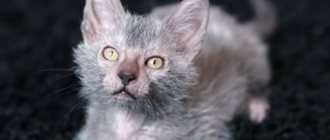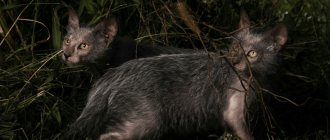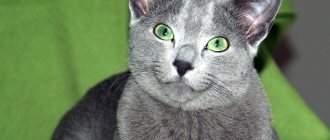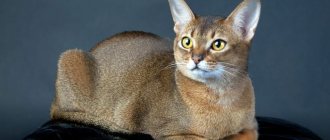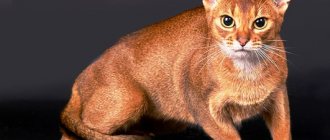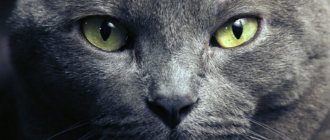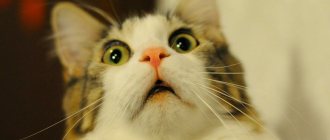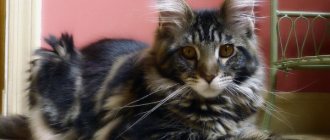Breed standard according to TICA classification
| Parameter | Grade |
| Head (40) | |
| Muzzle/chin/nose | 10 |
| Form | 10 |
| Ears | 8 |
| Eyes | 6 |
| Profile | 3 |
| Neck | 1 |
| Body (30) | |
| Frame | 7 |
| Musculature | 7 |
| Limbs/paws | 6 |
| Backbone | 6 |
| Tail | 4 |
| Coat (30) | |
| Texture | 15 |
| Color/pattern | 10 |
| Length | 5 |
General description : Likoi appeared as a result of a natural mutation from two domestic mongrel cats. Representatives of the breed are distinguished by a unique coat color, characterized as roan. The unusual color of the coat and its small amount give the cat an unusual appearance, reminiscent of a werewolf.
| Parameter | Description |
| Head | Shape: Modified wedge with rounded lines from nose to cheeks. The forehead is slightly rounded, slightly longer than wide. |
| Muzzle/chin/nose | Muzzle of medium length. Fleshy, softly rounded hairless whisker pads, pinch. The muzzle ends in a well-developed chin, aligned vertically with the nose, and having a rounded shape. The nose is bald, leathery to the touch, slightly pointed downwards and rounded at the end. There is a mask characterized by the absence of hair. |
| Ears | Large, wide at the base and pointed at the tips. Located high on the head, erect. The outer surface is covered with sparse hair. |
| Eyes | The large ones, shaped like a walnut, are directed obliquely upward. The expression of the eyes is open. There is no fur around the eyes. Golden eye color is preferred. |
| Profile | A concave curve from the forehead to the bridge of the nose. |
| Neck | Middle length. Neither thin nor overly muscular. |
| Body | Case: foreign type. The muscles are flexible and slender. |
| Limbs | The limbs are sparsely covered with hair, the paws may be hairless. Middle length. Paws are medium in size and oval in shape. The fingers are long. |
| Backbone | Average. |
| Tail | The tail is shorter than the body, tapering towards the tip. |
| Coat | The coat is not dense, soft to the touch, from short to medium length. The undercoat is minimal. The guard hair covering the body is long. The amount of hair varies depending on the season. In appearance, the fur resembles that of an opossum. |
| Color | Roan - ranging from 30% to 70% dark black hair from roots to tips, mixed with white hair from roots to tips. The ideal ratio is 50 to 50. White hair is distributed throughout the body. Individuals with a different coat color are allowed for breeding, but not for exhibitions. |
Outcrossing : shorthaired cats with a solid black color.
Disadvantages : sparse coat.
Disqualification:
- Absence of a bald mask on the face;
- Any primary coat color except black;
- No roan hair;
- The animal is completely covered with fur;
- Aggression or cowardice;
- In adult cats, the testes are not descended into the scrotum;
- Tail defects;
- Congenital mutations of the fingers;
- Strabismus;
- Blindness.
History of the origin of the Likoi breed
In 2010, two kittens with a unique appearance were born. The cat's owner, Patti Thomas, from Virginia (USA) contacted the breeders of Canadian Sphynx cats, the Gobble couple, because she believed that the kittens were somehow related to the breed. This theory was later refuted by a DNA test.
John Gobble, interested in unusual kittens, studied a lot of information and came across an article that talked about the birth of similar kittens in Tennessee, their mother was a black short-haired domestic cat.
In order to prove that a special gene is responsible for their appearance, the Gobble spouses deliberately attempted to breed cats. To do this, we took individuals from different litters. In 2011, a cat was born who was named Datiana. As a result, it was possible to establish that a recessive gene is responsible for the mutation.
All born kittens were examined, during which no genetic diseases, skin pathologies or diseases causing partial hairlessness were identified. It was possible to detect a lack of follicles, which explained the almost complete absence of undercoat, and to learn that cats shed to the point of complete hair loss.
Further work consisted of preparing documents and sending them to TICA in order to recognize the new breed. In 2012, the breed was officially recognized by TICA. Currently, the cats are bred in a cattery in Tennessee, from where the kittens went to breeders from the USA, Canada, and France.
Since the origin involved domestic outbred cats, they did not resort to the use of purebred animals in breeding. Subsequently, participation in the breeding of short-haired cats was reduced to a minimum. Breeders have focused on producing only black cats that carry the Lykoy gene. Outcrossing allows you to expand the gene pool and avoid the birth of sick kittens.
History of the breed
An American Shorthair cat gave birth to kittens with partial hairlessness.
Their owner was Patti Thomas. She assumed that the kittens were born sick. However, they grew and developed like ordinary ones. Because of the strange appearance of the kittens, she named them Lika, which translated from Greek means “werewolves.” Due to their resemblance to them, the kittens received the name of the new breed. Outwardly, they resembled sphinxes. Patti Thomas showed them to a Canadian breeder, John Gobble. He conducted research to determine whether the unusual cats were Sphynxes or Devon Rexes. DNA testing took place at the University of California, Davis. It was found that cats do not belong to the named species; they were found to have the same recessive gene. There are no known diseases that cause baldness.
John Gobble found the same cats in Tennessee. This helped develop a new breed. After a year of work by the breeders, in the fall of 2011, the second generation of kittens with fixed genotypes was born. It took another year to polish the new standard. In 2012, it was confirmed by the world's leading felinologists.
As a result, a new species of cat, the Likoi, was officially registered. It appeared in Russia only in 2016. At that time, 54 show-class cats were registered. Moreover, 32 of them were roan in color, and the rest were blue. In 2022, the only nursery appeared in Russia where Likoi is bred. The first kittens were delivered there from the USA.
Peculiarities
Several names for the breed were proposed, but the choice fell on “Likoy,” a word from Greek translated as “werewolf” and meaning a mythical creature that is reborn into a wolf. However, representatives of the breed did not arise in a mystical way, but through natural mutation and do not at all possess the features of a monster.
Lykoi has no genetic similarity to the Sphynx and Devon Rex. This fact is confirmed by the results of DNA tests carried out repeatedly.
The folded skin of the breed is very sensitive to high temperatures. Just a few hours in the sun and dark pigment spots appear on the skin, and exposure to sunlight for several days leads to a complete tan, with the skin becoming pitch black. The same effect is produced by exposure to heat, for example, if a cat sleeps on a radiator. But a few weeks without direct exposure to the sun and heat, and the skin takes on a natural pink color.
Personality of Likoy cats
Lykois are very attached to family members, making them considered ideal family pets. But only if they are taken care of and given attention. With those whom the cat trusts, she is affectionate and playful.
Animals prefer to spend more time with people, but if they happen to be left alone, cats find activities for themselves, for example, they enthusiastically play with toys or any other objects in the room. There is no need to be bored if there are several cats or a dog in the house.
Likoy reacts to strangers in the house with restraint and caution, anticipating potential danger. If there is a threat to itself, the cat may attack or bite, which is especially true for curious or aggressive dogs. But some time after meeting, having ruled out a threat to himself, the stranger will receive a friendly attitude from the cat.
Lykoi can make a person feel uneasy with just a glance. Sometimes it seems that cats look through a person with open yellow eyes, they are able to read thoughts, their gaze is so soulful.
Smart cats show intelligence when solving problems that arise during the game. They do an excellent job with intellectual toys, finding ways to achieve a goal, for example, getting a parrot out of a cage.
In terms of temperament, Lykoi are compared to hound breeds of dogs, endowed with an excellent sense of smell and distinguished by a developed hunting instinct. If there are other pets living in the house, for example, a parrot, a hamster, then they can become prey for Lykoi. The cat will bring its prey to its owner’s feet without the slightest embarrassment. Lykoi love to hunt and do it excellently. Toys and the owner's legs can become objects of hunting. The prey instinct manifests itself most strongly during the game.
Character
The Likoi breed is distinguished by its character. A cat can instantly change its mood - from affection to anger. Especially if a stranger appears in the house. The cat begins to actively defend its territory (no worse than a dog). His priority is protecting his family members. But as soon as the cat realizes that there is no threat, he becomes friendly again.
Lykoi are often aggressive towards other animals. A cat can attack even a large dog. Therefore, it is difficult for pets to get along with other animals. But cats are very kind to their owner and family members, loyal if they feel love, attention, and care.
They love the company of their owners, are not afraid to be alone, they will find something to do. Therefore, they are suitable for people who are rarely at home. The temperament of cats is similar to hounds.
Lykoy has a sharp mind; when he plays, he shows rare resourcefulness and quick wits (for example, when he needs to get a bird out of a locked cage). These qualities are given to cats by nature. The productivity of hunting in wild individuals depends on their dexterity and intelligence. Pets have also retained these qualities. If you walk them outside, do so only on a leash, otherwise they may run away.
Maintenance and care
Unlike other breeds, the Lykoi needs more frequent bathing, because a coating of sweat forms on the bare areas of the body. Bathing can be replaced by cleansing the skin with wet wipes. By the way, cats of this breed have a negative attitude towards water.
Clean the ears once a week and regularly monitor the condition of the eyes. It should be noted that the claws of representatives of the breed grow quickly. They also need weekly care.
Lykoi shed intensively, all hair may fall out during the molting period. Over the course of a year, animals grow new hair, which is darker or lighter than the old one and can cover the entire body.
Care
It may seem that the Lykoi does not need special care for its coat, but some of it does not exist. However, with this peculiarity, Lykoi shed very heavily and can periodically remain completely without hair. In this case, they need special care. Hairless cats get cold faster, so owners should think about how to help their pets maintain the warmth they need. Firstly, suitable temperature conditions at home must be created for this. Secondly, the cat must have special clothing that will allow it to calmly survive the cold season.
It is noteworthy that Lykoi love to be combed. They themselves enjoy spending time licking their fur. Therefore, you should not neglect this procedure.
Hurry up, choose a box and find out what gift awaits you
Discount on pet insurance
Promo code copied to clipboard
Lykoi kittens
Externally, kittens are almost no different from adults. They look ragged and awkward with prominent large ears. Kittens are born with a variety of coat colors, but only those with solid black roan coats are accepted for exhibition.
It is noteworthy that kittens are born with solid black fur. But after the first molt, at two to four weeks of age, new white and black hairs grow. The color is called “roan” and is found in dogs and horses. DNA analysis showed that the pattern is not tabby.
From birth, kittens have no hair around the eyes, chin, nose and outer top of the ears. The ears and nose are leathery to the touch. The legs of most individuals are covered with sparse hair.
Mature males can be significantly larger than females.
